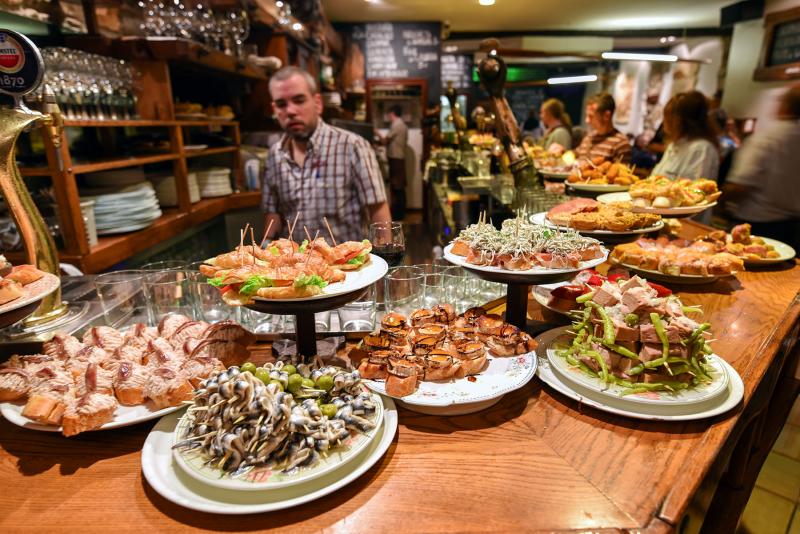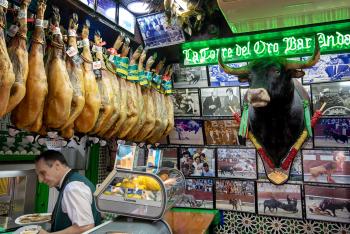Spain's tapas: Tasty and convivial
Appears in the Online Edition, June 2019.
When it comes to eating in Spain, I love gathering around the table or bar for tapas -- a parade of small dishes served family style. I never tire of them. The experience is like an edible scavenger hunt, where I collect small portions of seafood, salads, meat-filled pastries and deep-fried tasties and piece them together for a light evening meal.
My tapas memories are vivid: In the heart of Spain's Andalucía region, on a warm summer evening, I elbow up to a Granada tapas bar that's bustling with chattering locals. I squint at a hand-scrawled chalkboard menu describing various offerings, from jamón (cured ham), to fritters, to grilled squid. Around me, ham hocks hang like bovine ballerinas from the ceiling, while gregarious Spaniards lean over each other to shout their next tapa order to the bartender. I flag down a bartender for a drink, and I'm delighted to get a free tapa, too. This is conviviality gone wild, and it's easy to get swept away in all the fun.
You can sample a variety of specialties, from snails to Spain's ratatouille (pisto) with quail eggs, for a few euros per plate. My go-to is pimientos de Padrón -- sautéed mini green peppers dressed with a delicate coat of salt and oil. These little peppers are usually mild, but one in 10 is spicy hot. It's dangerous, like Russian roulette for your taste buds. Tapas are an opportunity to eat adventurously -- and an authentic, affordable way to sample local dishes.
In Spain, much of the day's eating revolves around tapas. To survive the Spanish eating schedule, adopt their eating style. Start off the day with a light coffee-and-roll breakfast. Around 11, a light meal (merienda) bridges the gap between breakfast and late lunch (often the main meal, at around 3 p.m.).
In Catalunya, lunch might be fideuà, a thin, flavor-infused noodle served with seafood. In green, rainy Galicia (in the northwest), look for octopus chopped up and dusted with paprika. Filling specialties like these can easily hold me over until my late-night tapas run. I usually opt for a simple bocadillo -- a baguette sandwich commonly stuffed with Spain's dry-cured delicacy: salty, succulent jamón.
Prosciutto-like jamón is a staple of both bocadillos and tapas. It's aged from happy, acorn-fed pigs, and its bold flavor embodies the rustic intensity of Spanish culture. Cured ham hocks -- toned legs with pointed toes -- are found in every bar. Like connoisseurs of fine wine, Spaniards debate the merits of different breeds of pigs, their diets, and the quality of the curing. In Spain, jamón is more than a food; it's a way of life. Spaniards treasure memories of Grandpa during Christmas, thinly carving a ham supported in a jamonero (ham-hock holder), just as we prize the turkey carving at Thanksgiving.
While tapas are served all day, the real action begins late -- 9 p.m.at the earliest. Because most Spaniards work until 7:30 p.m., a light supper at 9 or 10 p.m. is typical. To find the most authentic tapas atmosphere, I look for noisy bars with piles of napkins and food debris on the floor (part of the tapas tradition), lots of locals, and the TV blaring. Popular television-viewing includes bullfights and soccer games, and Spanish interpretations of soaps and silly game shows.
Arguably the country's culinary capital is San Sebastian, in Spain'sBasque Country. Here, tapas are called pintxos. Part of the Basque experience is txiquiteo -- hopping from bar to bar, enjoying wine, small open-faced sandwiches, and tiny snacks of peppers, mushrooms, and nuts. While tempting cold pintxos are always on display and ready to be gobbled up, I like to order off the menu of hot pintxos (pintxos calientes) for something fresh from the kitchen -- like spider crab or beef cheeks in a red wine sauce. Regardless of what you order, tapas are usually eaten standing at the bar, where it's easier to mingle and cheaper than eating at a table.
At any tapas bar, I jump (like everyone else) at the opportunity to snare a small plate of paella when it appears hot out of the kitchen. This dish is a fine reminder of how 700 years of Muslim rule left its mark on Spanish cuisine. The Moors were great horticulturists and introduced Spain to new herbs and spices -- a legacy that's well represented in paella. Traditional Middle Eastern saffron combines with rice, seafood, sausage, and chicken for a recipe that is quintessentially Spanish.
For an affordable and accessible slice of Spanish culture, dive headfirst into the tapas experience. You'll be rewarded with bite-size punches of flavor, a reasonable bill, and the unrelenting energy of the locals that surround you.
(Rick Steves (www.ricksteves.com) writes European travel guidebooks and hosts travel shows on public television and public radio. Email him at rick@ricksteves.com and follow his blog on Facebook.)


